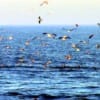 By Ed Snyder/Outdoors
By Ed Snyder/Outdoors
Bolivar Peninsula,TX
The high pitched shrieks and feathered splashes alerted us to the frantic melee ongoing just 100 yards away. One minute we were fishing sea-grass edges looking for a bite, and the next we were at full throttle headed for a fight! A gaggle of shrieking seagulls diving and fighting over a watery expanse of Galveston’s East Bay became my focal point. Running our boat to within 50 yards of this noisy fracas, we shut down our engine and dropped in the troll-motor before picking up fishing rods to quickly cast into the melee. After two cranks of my reel the fight was on!

Birds diving over feeding trout in East Bay
The months of November/December/January offer some of the best fishing action of the year for the Galveston Bay area as the cooling effects of Autumn initiates a phenomenon of hungry sea birds and feeding trout. This occurs when cooling bay waters draw schools of baitfish or shrimp together in tight pods for migrating to the warmer waters of the Gulf. When this happens, marauding schools of trout ambush these rafts of prey into massive, frenzied, feeding sprees of fish, panicked prey, and diving seagulls.
Spotting these aggressive feeding sprees with flocking birds diving and feeding on surfacing baitfish is easy. Just watch and listen for them. A good set of binoculars and alert hearing will get you in on some of the hottest action of the year. This could be just one bird diving low over the surface or 100 birds diving in a frenzy of feeding. If the birds are high in the air this means they’re looking, but if you see them diving low over the surface this means they’re feeding. What happens is the school of specks will push the shrimp or bait fish up to the surface, which in turn attracts the hungry birds.

Surf anglers working a flock of feeding pelicans
The perfect tackle for this type of angling are bait casters or spinning reels matched with 7-ft medium action rods. Reels spooled with 12-lb test fluorocarbon or mono line makes for smoother casting and better hookups. My tackle includes Lews Speed Reels and Lews IM6 carbon rods rigged with ¾ ounce silver spoons.
When the birds are diving over feeding trout they will hit just about anything, including an assortment of soft plastics, top water lures, and live bait under popping corks, but your casting distance will be very limited, while the weight and shape of the spoon allows for longer casts. The spoons are the key for distance casting for catching schooling specks and avoiding getting too close and spooking the school of specks off the bite, thus killing the feeding spree.
My tackle pack has an assortment of soft plastics which include Saltwater Assassins and Berkley Gulp in pearl/chartreuse and pumpkinseed/chartreuse, MirrOlure soft plastics in chartreuse/gold and salt/pepper. These are among my top lures in soft plastics for topwater action BUT the 3/4 oz silver or gold spoons are my #1 choice for this type of action. Another important item to have on board is a pair of binoculars for spotting feeding birds on the horizon. This has been one of my most productive tools to have and has helped to fill my limits on many occasions.
Hard plastics such as Mirror lures (subsurface or top waters) are excellent choices for this type of action, BUT they have multiple hooks and cause problems with dehooking fish as well as problems with hooking anglers. So I don’t recommend them when casting under feeding birds, which also may get hooked on them. And believe me, you don’t want to be dehooking a bird while in the middle of a feeding frenzy.

Speckled trout limits are 10 specks at 15 inches, with only one allowed over 25 inches, and the redfish, which are often mixed in with the trout, are 3 slot reds at 20 to 28 inches with only one over 28 inches if tagged.
When the birds fly off, you may think the actions over and leave, but wait 5 minutes or so to see if the fish have really left. I’ve experienced the fish re-schooling several times without the birds feeding over them when the fish reappear to start feeding again.
The best times for fishing East Bay birds is always early/30 (7:30AM) when they’ll be active from daybreak till about 10am. Then 4:30PM in the afternoon till evening hours will provide some good action as well.
Some bird activity may only last 5 or 10 minutes with others lasting an hour or more. I’ve fished under birds lasting over an hour, catching and releasing 65 specks in one feeding spree alone. That extended feeding event had three other boats working the same school where we all respected our space and kept busy catching trout and having fun. So the action is there if you take care on how you join in on the fishing. Use the common sense factor and we all will appreciate, the birds will appreciate, and the trout will appreciate!

This Ed Snyder/Outdoors Article Sponsored by Miss Nancy’s Bait Camp, Crystal Beach Local News.com, and The Beach Triton.
(published 12/22/2014)

 Posted in
Posted in 























